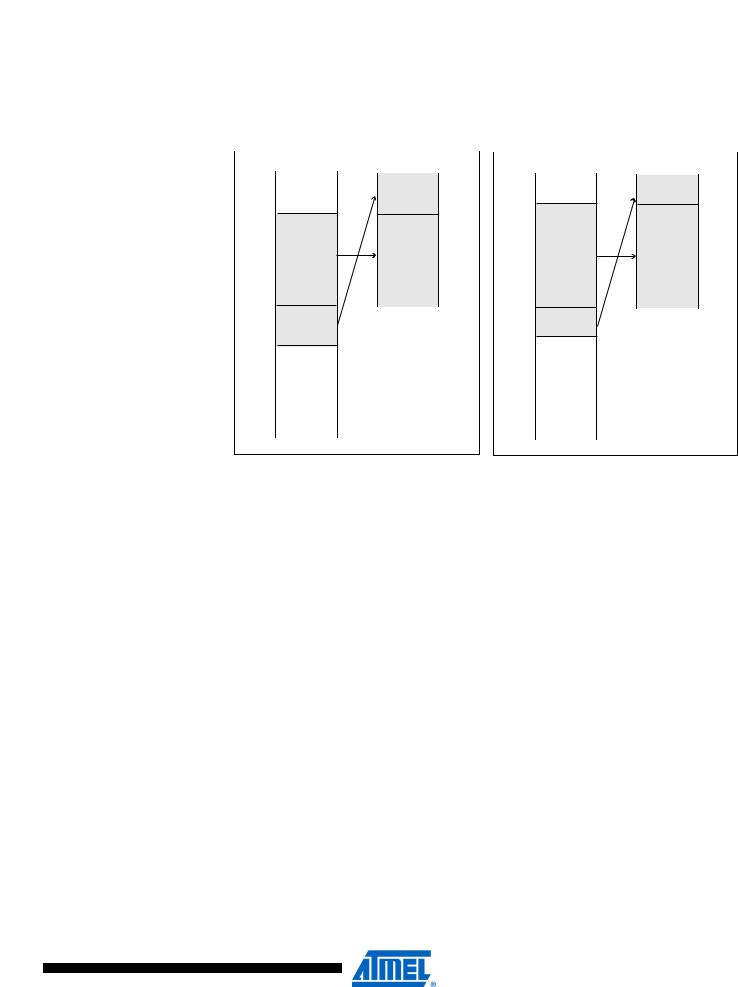
- •Features
- •Overview
- •Block Diagram
- •Pin Descriptions
- •Port A (PA7..PA0)
- •Port B (PB7..PB0)
- •Port C (PC7..PC0)
- •Port D (PD7..PD0)
- •Port E (PE7..PE0)
- •Port F (PF7..PF0)
- •Port G (PG4..PG0)
- •RESET
- •XTAL1
- •XTAL2
- •AVCC
- •AREF
- •Resources
- •Data Retention
- •Capacitive touch sensing
- •AVR CPU Core
- •Introduction
- •Status Register
- •Stack Pointer
- •I/O Memory
- •Overview
- •Timing
- •Using all Locations of External Memory Smaller than 64 Kbyte
- •Clock Systems and their Distribution
- •CPU Clock – clkCPU
- •I/O Clock – clkI/O
- •Flash Clock – clkFLASH
- •ADC Clock – clkADC
- •Clock Sources
- •Crystal Oscillator
- •External Clock
- •Idle Mode
- •Power-down Mode
- •Power-save Mode
- •Standby Mode
- •Analog Comparator
- •Brown-out Detector
- •Watchdog Timer
- •Port Pins
- •Resetting the AVR
- •Reset Sources
- •Power-on Reset
- •External Reset
- •Watchdog Reset
- •Watchdog Timer
- •Timed Sequences for Changing the Configuration of the Watchdog Timer
- •Safety Level 0
- •Safety Level 1
- •Safety Level 2
- •Interrupts
- •I/O Ports
- •Introduction
- •Configuring the Pin
- •Reading the Pin Value
- •Unconnected pins
- •Alternate Port Functions
- •Register Description for I/O Ports
- •8-bit Timer/Counter0 with PWM and Asynchronous Operation
- •Overview
- •Registers
- •Definitions
- •Counter Unit
- •Normal Mode
- •Fast PWM Mode
- •8-bit Timer/Counter Register Description
- •Overview
- •Registers
- •Definitions
- •Compatibility
- •Counter Unit
- •Input Capture Unit
- •Noise Canceler
- •Force Output Compare
- •Normal Mode
- •Fast PWM Mode
- •16-bit Timer/Counter Register Description
- •Internal Clock Source
- •Prescaler Reset
- •External Clock Source
- •8-bit Timer/Counter2 with PWM
- •Overview
- •Registers
- •Definitions
- •Counter Unit
- •Normal Mode
- •Fast PWM Mode
- •8-bit Timer/Counter Register Description
- •Output Compare Modulator (OCM1C2)
- •Overview
- •Description
- •Timing Example
- •Slave Mode
- •Master Mode
- •Data Modes
- •USART
- •Dual USART
- •Overview
- •AVR USART vs. AVR UART – Compatibility
- •Clock Generation
- •External Clock
- •Frame Formats
- •Parity Bit Calculation
- •Parity Generator
- •Receiver Error Flags
- •Parity Checker
- •Disabling the Receiver
- •Using MPCM
- •Features
- •TWI Terminology
- •Transferring Bits
- •Address Packet Format
- •Data Packet Format
- •Overview of the TWI Module
- •Scl and SDA Pins
- •Bus Interface Unit
- •Address Match Unit
- •Control Unit
- •Using the TWI
- •Master Receiver Mode
- •Slave Receiver Mode
- •Miscellaneous States
- •Analog Comparator
- •Analog to Digital Converter
- •Features
- •Operation
- •Changing Channel or Reference Selection
- •ADC Input Channels
- •Analog Input Circuitry
- •Features
- •Overview
- •TAP Controller
- •PRIVATE0; $8
- •PRIVATE1; $9
- •PRIVATE2; $A
- •PRIVATE3; $B
- •Bibliography
- •Features
- •System Overview
- •Data Registers
- •Bypass Register
- •Reset Register
- •EXTEST; $0
- •IDCODE; $1
- •AVR_RESET; $C
- •BYPASS; $F
- •Scanning the ADC
- •ATmega128 Boundary-scan Order
- •Application Section
- •Programming Time for Flash when Using SPM
- •Simple Assembly Code Example for a Boot Loader
- •Fuse Bits
- •Latching of Fuses
- •Signature Bytes
- •Calibration Byte
- •Signal Names
- •Chip Erase
- •Reading the Flash
- •Reading the EEPROM
- •Data Polling Flash
- •Data Polling EEPROM
- •AVR_RESET ($C)
- •PROG_ENABLE ($4)
- •Data Registers
- •Reset Register
- •Programming Enable Register
- •Programming Command Register
- •Virtual Flash Page Read Register
- •Performing Chip Erase
- •Reading the Flash
- •Reading the EEPROM
- •Electrical Characteristics
- •Absolute Maximum Ratings*
- •DC Characteristics
- •Speed Grades
- •External Clock Drive Waveforms
- •External Clock Drive
- •Two-wire Serial Interface Characteristics
- •ADC Characteristics
- •External Data Memory Timing
- •Idle Supply Current
- •Pin Pull-up
- •Pin Driver Strength
- •Register Summary
- •Instruction Set Summary
- •Ordering Information
- •Packaging Information
- •Errata
- •ATmega128 Rev. F to M

 ATmega128
ATmega128
External Memory
Control Register B –
XMCRB
Bit |
7 |
6 |
5 |
4 |
3 |
2 |
1 |
0 |
|
|
XMBK |
– |
– |
– |
– |
XMM2 |
XMM1 |
XMM0 |
XMCRB |
|
|
|
|
|
|
|
|
|
|
Read/Write |
R/W |
R |
R |
R |
R |
R/W |
R/W |
R/W |
|
Initial Value |
0 |
0 |
0 |
0 |
0 |
0 |
0 |
0 |
|
• Bit 7– XMBK: External Memory Bus-keeper Enable
Writing XMBK to one enables the bus keeper on the AD7:0 lines. When the bus keeper is enabled, it will ensure a defined logic level (zero or one) on AD7:0 when they would otherwise be tri-stated. Writing XMBK to zero disables the bus keeper. XMBK is not qualified with SRE, so even if the XMEM interface is disabled, the bus keepers are still activated as long as XMBK is one.
• Bit 6..4 – Res: Reserved Bits
These are reserved bits and will always read as zero. When writing to this address location, write these bits to zero for compatibility with future devices.
• Bit 2..0 – XMM2, XMM1, XMM0: External Memory High Mask
When the External Memory is enabled, all Port C pins are default used for the high address byte. If the full 60 Kbyte address space is not required to access the External Memory, some, or all, Port C pins can be released for normal Port Pin function as described in Table 5. As described in “Using all 64 Kbyte Locations of External Memory” on page 34, it is possible to use the XMMn bits to access all 64 Kbyte locations of the External Memory.
Using all Locations of External Memory Smaller than 64 Kbyte
Table 5. Port C Pins Released as Normal Port Pins when the External Memory is Enabled
XMM2 |
XMM1 |
XMM0 |
# Bits for External Memory Address |
Released Port Pins |
|
|
|
|
|
0 |
0 |
0 |
8 (Full 60 Kbyte space) |
None |
|
|
|
|
|
0 |
0 |
1 |
7 |
PC7 |
|
|
|
|
|
0 |
1 |
0 |
6 |
PC7 - PC6 |
|
|
|
|
|
0 |
1 |
1 |
5 |
PC7 - PC5 |
|
|
|
|
|
1 |
0 |
0 |
4 |
PC7 - PC4 |
|
|
|
|
|
1 |
0 |
1 |
3 |
PC7 - PC3 |
|
|
|
|
|
1 |
1 |
0 |
2 |
PC7 - PC2 |
|
|
|
|
|
1 |
1 |
1 |
No Address high bits |
Full Port C |
|
|
|
|
|
Since the external memory is mapped after the internal memory as shown in Figure 11, the external memory is not addressed when addressing the first 4,352 bytes of data space. It may appear that the first 4,352 bytes of the external memory are inaccessible (external memory addresses 0x0000 to 0x10FF). However, when connecting an external memory smaller than 64 Kbyte, for example 32 Kbyte, these locations are easily accessed simply by addressing from address 0x8000 to 0x90FF. Since the External Memory Address bit A15 is not connected to the external memory, addresses 0x8000 to 0x90FF will appear as addresses 0x0000 to 0x10FF for the external memory. Addressing above address 0x90FF is not recommended, since this will address an external memory location that is already accessed by another (lower) address. To the Application software, the external 32 Kbyte memory will appear as one linear 32 Kbyte address space from 0x1100 to 0x90FF. This is illustrated in Figure 17. Memory configuration B refers to the ATmega103 compatibility mode, configuration A to the non-compatible mode.
When the device is set in ATmega103 compatibility mode, the internal address space is 4,096 bytes. This implies that the first 4,096 bytes of the external memory can be accessed at
32
2467X–AVR–06/11

 ATmega128
ATmega128
addresses 0x8000 to 0x8FFF. To the Application software, the external 32 Kbyte memory will appear as one linear 32 Kbyte address space from 0x1000 to 0x8FFF.
Figure 17. Address Map with 32 Kbyte External Memory
|
|
Memory Configuration A |
|
|
|
Memory Configuration B |
||||||
|
|
|
|
|
|
|
|
|
|
|
|
|
|
|
AVR Memory Map |
|
External 32K SRAM |
|
|
|
|
|
|
||
|
|
|
|
|
|
AVR Memory Map |
|
External 32K SRAM |
||||
0x0000 |
|
|
|
|
0x0000 |
|
0x0000 |
|
|
|
|
0x0000 |
|
Internal Memory |
|
|
|
|
Internal Memory |
|
|
||||
|
|
|
|
|
|
0x0FFF |
|
|
0x0FFF |
|||
|
|
|
|
|
|
|
|
|
|
|||
0x10FF |
|
|
|
0x10FF |
|
0x1000 |
|
|
|
0x1000 |
||
0x1100 |
|
|
0x1100 |
|
|
|
|
|
|
|
||
0x7FFF |
External |
|
|
0x7FFF |
0x7FFF |
External |
|||
|
|
|
|
|
|
0x7FFF |
|||
0x8000 |
Memory |
|
|
|
0x8000 |
Memory |
|||
0x90FF |
|
|
|
|
0x8FFF |
|
|
|
|
0x9100 |
|
|
|
|
0x9000 |
|
|
|
|
|
(Unused) |
|
|
|
|
(Unused) |
|||
0xFFFF |
|
|
|
|
0xFFFF |
|
|
|
|
|
|
|
|
|
|
|
|
||
33
2467X–AVR–06/11

 ATmega128
ATmega128
Using all 64 Kbyte Since the External Memory is mapped after the Internal Memory as shown in Figure 11, only 60 Locations of External Kbyte of External Memory is available by default (address space 0x0000 to 0x10FF is reserved Memory for internal memory). However, it is possible to take advantage of the entire External Memory by masking the higher address bits to zero. This can be done by using the XMMn bits and control by software the most significant bits of the address. By setting Port C to output 0x00, and releasing the most significant bits for normal Port Pin operation, the Memory Interface will address
0x0000 - 0x1FFF. See the following code examples.
Assembly Code Example(1)
;OFFSET is defined to 0x2000 to ensure
;external memory access
;Configure Port C (address high byte) to
;output 0x00 when the pins are released
;for normal Port Pin operation
ldi r16, 0xFF out DDRC, r16 ldi r16, 0x00 out PORTC, r16 ; release PC7:5
ldi r16, (1<<XMM1)|(1<<XMM0) sts XMCRB, r16
;write 0xAA to address 0x0001 of external
;memory
ldi r16, 0xaa
sts 0x0001+OFFSET, r16
;re-enable PC7:5 for external memory ldi r16, (0<<XMM1)|(0<<XMM0)
sts XMCRB, r16
;store 0x55 to address (OFFSET + 1) of
;external memory
ldi r16, 0x55
sts 0x0001+OFFSET, r16
C Code Example(1)
#define OFFSET 0x2000
void XRAM_example(void)
{
unsigned char *p = (unsigned char *) (OFFSET + 1);
DDRC = 0xFF;
PORTC = 0x00;
XMCRB = (1<<XMM1) | (1<<XMM0);
*p = 0xaa;
XMCRB = 0x00;
*p = 0x55;
}
Note: 1. See “About Code Examples” on page 8.
Care must be exercised using this option as most of the memory is masked away.
34
2467X–AVR–06/11
